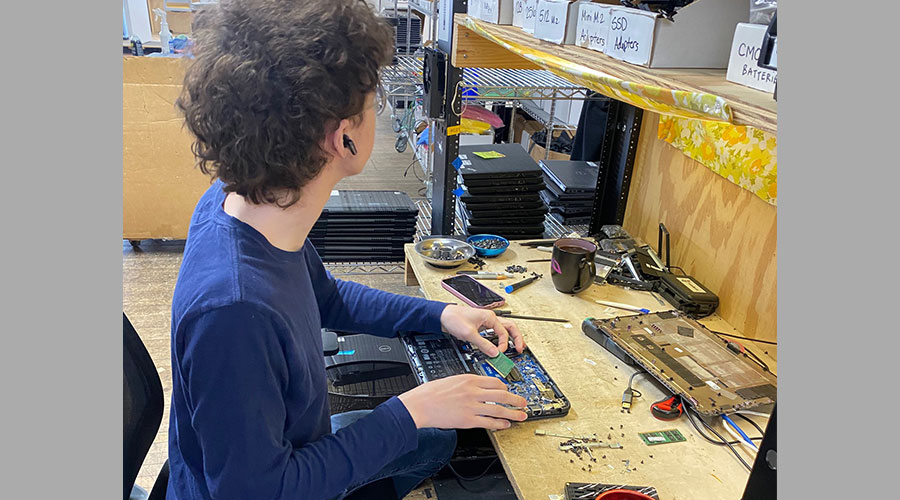Balancing IAQ and Green
Attention to maintenance, operations and design can result in buildings that are healthy for occupants and friendly to the environment
While much has been written about green buildings, widespread confusion exists as to just what constitutes a green building. What does such a building look like? How is it different from a conventional building? What does it take to make a building green?
A green building is one in which indoor and outdoor environmental factors have been considered and protected over the life cycle of a building. These factors include the sustainability of the site, water-use efficiency, energy, materials and resources required for construction, and the indoor environmental quality.
Managers who have succeeded in achieving both goals have done so through a process of focusing on issues such as ventilation, operations and maintenance. Ignoring these issues can result in a building being neither green nor energy efficient.
Design also plays a central role in achieving both goals. For more information, see the accompanying article on this page.
Ventilation
If a building is to meet the needs of the occupants while remaining green, systems must be carefully designed to meet the needs of building occupants and visitors. One indoor air quality (IAQ) issue involves supplying sufficient outdoor air to occupied spaces. A ventilation rate that is too low and a contaminant buildup can make working conditions unhealthy. A ventilation rate that is too high wastes energy.
Providing enough ventilation based on occupancy is particularly difficult in variable-air-volume systems. While these systems typically have a minimum ventilation rate based on code and occupancy, their operation is driven primarily by space temperatures. As a result, the ventilation rate often is too high or too low for the space occupancy.
New building controls can help match ventilation rates to needs. For example, carbon dioxide and occupancy sensors can be specified to set ventilation rates based on actual conditions in the occupied space. Matching ventilation-supply rates to actual requirements curtails energy used to condition outside air, while maintaining proper environmental conditions in the space.
While ventilation rates can help keep IAQ within a desired range, building designs also must look to control the source of pollutants generated within the building. For example, office equipment can generate high levels of a range of pollutants, including ozone. By designing air systems serving these areas so they remove pollutants before they spread, managers can maintain IAQ without relying on high and costly levels of ventilation air.
Most importantly, system designers must not become so focused on one part of a building and lose sight of the big picture. HVAC systems tend to be designed in isolation, so they go ignored unless other systems contribute to the heating or cooling load.
But few building systems operate in isolation. The way one system performs impacts most other systems. With the advent of interoperable building controls, designers can fully integrate systems. Failing to take full advantage of the interaction between systems and opportunities for interoperability limits the capabilities of installed systems.
Operations
No matter how good the design, buildings will remain green only if technicians operate them properly. Changing ventilation settings to supply more air to one area might solve ventilation requirements for that area, but it robs other areas. Similarly, overriding controls to correct a problem does not really solve the problem, it only masks it. And doing so is likely to create additional problems elsewhere in the building.
Good operating practices for building ventilation systems are everyone’s responsibility. Maintenance technicians must take the time to properly diagnose operating problems to find the proper remedy, rather than simply patching it. And managers must see that technicians have the tools, equipment, supplies and training required to operate the equipment and building systems properly.
Most importantly, managers must make it understood that poor operating practices and quick fixes are unacceptable in maintaining IAQ and the building’s green status.
Maintenance
The most important — yet frequently overlooked — element in trying to achieve both green status and healthy IAQ is proper maintenance. Too many buildings operate under the no-maintenance mentality: If something is working, leave it alone.
Similarly, system components might need maintenance, and managers might know that components require maintenance, but sufficient funds might not be available to perform the activities. So the maintenance is deferred.
Unfortunately, failure to properly maintain HVAC systems, particularly ventilation systems, will result in increased energy requirements and worsening IAQ. From the day of installation, systems deteriorate.
Ventilation systems go out of balance. Temperature control systems go out of calibration. Components fail. The rate of change generally is so slow that it goes unnoticed to the occupants and, therefore, rarely gets recognized as a maintenance problem.
The best defense against this slow deterioration is an ongoing maintenance testing and monitoring program. Both must be performed on a regular basis if managers expect the systems to continue operating efficiently and without loss of air quality.
A good maintenance program also requires that when problems occur, technicians fix them properly. It is a strong temptation for maintenance personnel, particularly in understaffed departments, to take shortcuts. Instead of taking the time to fully diagnose a problem, they resort to patches. It isn’t long before the patches need patches.
Unfortunately, patches mask problems rather than actually correcting them. And with each patch and quick fix, system performance and IAQ can suffer.
Being green and providing proper IAQ is not difficult. While it requires that managers be willing to change the way they and their departments do business, the payoff in reduced operating costs, improved IAQ, reduced health liability, and increased occupant productivity and retention makes the change worthwhile.
Design that Delivers IAQ
The need for green buildings and good indoor air quality (IAQ) has greatly affected building design. Traditional design has relied largely on the path of least resistance. This path follows the same processes used in the past, with only minor changes. It features similar materials and building systems.
Most of today’s systems are tried and true. Designers are confident that their new designs will succeed because it is based on successful designs.
But problems occur in defining success. In the past, success had meant completing the project on budget and on time. Few people defined success as designing a building with low life-cycle costs or one that provides a healthy environment for its occupants.
Today, the situation has changed. Low first costs no longer can be considered the major driving factor in building design. Besides low first costs, a successful building design today must have low life-cycle costs, good environmental properties, and low energy costs. In short, they must be green.
Today’s successful designs, particularly those involving HVAC systems, must break with the tradition. For example, it had been common practice to oversize ventilation and distribution systems by up to 15-25 percent to provide spare capacity, oversizing results in lowered energy efficiency, as well as higher operating costs, and installed costs.
|
No More ‘One or the Other’
Not long ago, it was an accepted fact that maintenance and engineering managers had to make a choice — operate an environmentally friendly facility or provide the best possible indoor environment for its occupants. The two choices were considered mutually exclusive.
In this scenario, measures that aimed to reduce energy requirements resulted in poorer indoor air quality (IAQ). And those measures implemented to improve IAQ would increase the building's energy requirements — going green meant higher costs.
Some managers blame many of today's building IAQ problems on energy conservation efforts that followed the energy crisis of the 1970s. High energy costs led to changes in the design and operation of buildings, changes that included tighter construction and lower ventilation rates. The result of these changes came to be called tight-building syndrome.
Today, after more than a decade of experience, managers of green facilities know that they can achieve both goals. Environmentally friendly facilities no longer are necessarily energy hogs, and energy-efficient buildings do not necessarily create working environments that are detrimental to occupants.
|
James Piper is a national facilities management consultant with more than 25 years of experience.
Related Topics:











